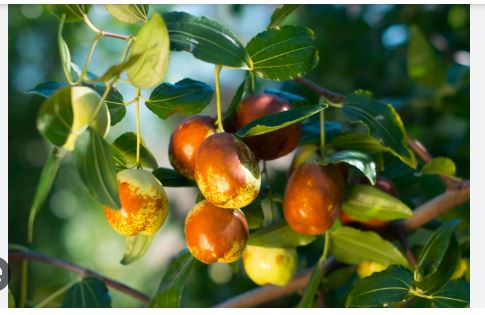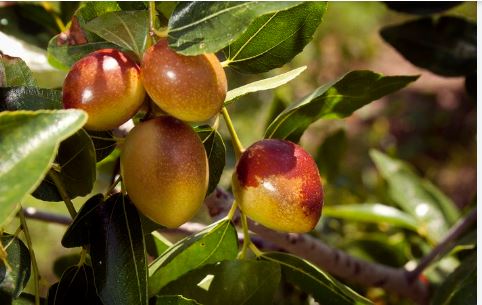
Botanical Classification
The Jujube, scientifically known as Ziziphus jujuba, belongs to the Rhamnaceae family, which includes buckthorns and other shrubs and trees. It is part of the genus Ziziphus, comprising about 40 species of spiny trees and shrubs, many of which produce edible fruits. Commonly called Chinese date, red date, or simply jujube, Ziziphus jujuba is a deciduous or semi-evergreen tree or shrub valued for its nutritious fruit. Its classification within the order Rosales aligns it with other fruit-bearing species like apples and almonds. The species name “jujuba” derives from the Arabic “zizouf,” reflecting its historical cultivation in the Middle East and Asia.
History
The Jujube has a rich history dating back over 4,000 years, originating in China, where it was domesticated and cultivated for its fruit and medicinal properties. Ancient Chinese texts, such as the Shennong Bencao Jing, document its use for improving health and longevity. It spread along the Silk Road to the Middle East, India, and Europe, becoming a staple in traditional medicine and diets. In the 19th century, jujube was introduced to the United States, particularly in the Southeast and Southwest, where cultivars like ‘Li’ and ‘Lang’ were developed for commercial fruit production. Its resilience and nutritional value have made it a symbol of sustenance in many cultures.
Identifying Characteristics
Ziziphus jujuba is a small to medium-sized tree or shrub, typically growing 15–35 feet tall with a spread of 10–20 feet. Its leaves are glossy, oval, 1–2 inches long, and alternate, with a vibrant green color that may turn yellow in fall. The bark is grayish-brown, becoming fissured with age, and branches often have small spines. Small, yellowish-green flowers bloom in late spring to early summer, followed by oval to round drupes (0.5–1 inch), which ripen from green to reddish-brown or black, with a sweet, date-like flavor. The tree’s irregular, spreading crown and drought tolerance make it distinctive in arid landscapes.
Distribution and Ecology
Native to China, Ziziphus jujuba is now cultivated across Asia, the Middle East, southern Europe, and parts of the Americas, thriving in warm, temperate to subtropical climates. It grows from sea level to 5,500 feet elevation, favoring well-drained, sandy, or loamy soils but tolerating poor, rocky, or alkaline conditions. Jujube is highly drought-tolerant and adapts to arid and semi-arid regions, making it valuable in desert agriculture. It supports pollinators like bees and provides food for birds and mammals, which disperse its seeds. In some regions, it is planted for erosion control and as a windbreak, enhancing agroecosystems.
Uses
Jujube is prized for its edible fruit, consumed fresh, dried, or processed into candies, teas, and pastes, valued for their sweet flavor and high vitamin C content. In traditional Chinese medicine, jujube fruit is used to treat insomnia, anxiety, and digestive issues, often combined with other herbs. The wood, though small in diameter, is hard and used for small tools, carvings, and fuel in rural areas. Ornamentally, jujube is planted in gardens and landscapes for its attractive foliage, fruit, and drought tolerance. Ecologically, it stabilizes soils, supports pollinators, and is used in agroforestry for its low water needs and resilience in harsh environments.
USDA Zones
Ziziphus jujuba is hardy in USDA Zones 6–9, thriving in warm, temperate to subtropical climates. It tolerates temperatures as low as 0°F once established, though young trees may need protection below 10°F. Zone 6 includes areas like parts of the southeastern U.S., while Zones 7–9 cover regions like California, Texas, and the Mediterranean, ideal for fruit production. Jujube requires full sun and moderate moisture but is highly drought-tolerant, making it suitable for arid zones. In colder zones, it can be grown in containers and brought indoors, though its fruit yield may be reduced in confined settings.

Jujube (Ziziphus jujuba) Tree: Cultivation
- Site Selection: Choose a site with full sun, as Jujube thrives in bright conditions and requires at least 6–8 hours of direct sunlight daily. Select open areas like orchards, gardens, or dry slopes, ensuring space for its spreading crown.
- Soil Requirements: Plant in well-drained soils with a pH of 5.5–8.5. Jujube adapts to sandy, loamy, or rocky soils and tolerates alkaline or nutrient-poor conditions, but avoid heavy clay or waterlogged soils that impede root development.
- USDA Hardiness Zones: Cultivate in USDA Zones 6–9, where Jujube is hardy. It withstands cold down to 0°F once established but may need protection for young trees in Zone 6. Zones 7–9, covering warmer regions, are ideal for optimal fruit production.
- Watering Needs: Provide moderate watering during the first 1–2 years to establish roots, especially in dry climates. Jujube is highly drought-tolerant once mature, requiring minimal irrigation, but occasional deep watering during fruiting enhances yield and quality.
- Planting Time: Plant in early spring after the last frost to allow root establishment during warm months. In warmer Zones 8–9, fall planting is also viable. Use grafted or container-grown saplings for reliable fruiting, as seed-grown trees may vary in quality.
- Spacing: Space trees 10–20 feet apart, depending on cultivar and purpose. Smaller cultivars (e.g., ‘Li’) can be spaced 10–15 feet, while larger ones (e.g., ‘Lang’) need 15–20 feet to accommodate their mature spread and ensure good air circulation.
- Propagation: Propagate via seeds, cuttings, or grafting. Seeds require scarification and soaking for 24 hours but produce variable fruit quality. Softwood or hardwood cuttings root with hormone treatment. Grafting (e.g., whip-and-tongue) onto rootstock ensures superior cultivars and faster fruiting.
- Fertilization: Apply a balanced, slow-release fertilizer (e.g., 10-10-10) in early spring during the first 2–3 years to promote growth and fruiting. Mature trees need minimal fertilization; organic compost or a light application of nitrogen boosts fruit yield in poor soils.
- Pruning: Prune in late winter or early spring to remove dead, damaged, or overcrowded branches and shape the tree for open structure. For fruit production, thin branches to improve light penetration and air flow, encouraging larger, healthier drupes.
- Pest and Disease Management: Monitor for pests like fruit flies or scale insects, which may affect fruit or foliage. Use organic controls like neem oil or traps. Jujube is relatively disease-resistant, but fungal issues like powdery mildew can be prevented with proper spacing and avoiding overhead watering.
- Mulching: Apply 2–3 inches of organic mulch (e.g., wood chips or straw) around the base to conserve moisture, suppress weeds, and regulate soil temperature. Keep mulch 2–3 inches from the trunk to prevent rot, especially in humid climates.
- Winter Care: In Zone 6, protect young trees from severe cold by wrapping trunks with burlap or mulching heavily around the base. Mature trees are cold-hardy but may lose leaves in winter, resuming growth in spring without issue.
- Landscape Use: Use Jujube as a fruit tree in orchards, a drought-tolerant ornamental in gardens, or a windbreak in agroforestry systems. Its attractive foliage, edible fruit, and low maintenance make it ideal for sustainable landscapes, though fruit drop may require cleanup in urban settings.